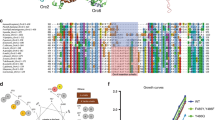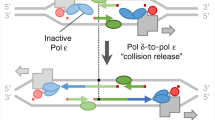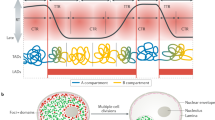Abstract
Highly activated transcription is associated with eukaryotic genome instability, resulting in increased rates of mitotic recombination and mutagenesis. The association between high transcription and genome stability is probably due to a variety of factors including an enhanced accumulation of DNA damage, transcription-associated supercoiling, collision between replication forks and the transcription machinery, and the persistence of RNA–DNA hybrids1. In the case of transcription-associated mutagenesis, we previously showed that there is a direct proportionality between the level of transcription and the mutation rate in the yeast Saccharomyces cerevisiae2, and that the molecular nature of the mutations is affected by highly activated transcription2,3. Here we show that the accumulation of apurinic/apyrimidinic sites is greatly enhanced in highly transcribed yeast DNA. We further demonstrate that most apurinic/apyrimidinic sites in highly transcribed DNA are derived from the removal of uracil, the presence of which is linked to direct incorporation of dUTP in place of dTTP. These results show an unexpected relationship between transcription and the fidelity of DNA synthesis, and raise intriguing cell biological issues with regard to nucleotide pool compartmentalization.
This is a preview of subscription content, access via your institution
Access options
Subscribe to this journal
Receive 51 print issues and online access
$199.00 per year
only $3.90 per issue
Buy this article
- Purchase on Springer Link
- Instant access to full article PDF
Prices may be subject to local taxes which are calculated during checkout


Similar content being viewed by others
References
Aguilera, A. The connection between transcription and genomic instability. EMBO J. 21, 195–201 (2002)
Kim, N., Abdulovic, A. L., Gealy, R., Lippert, M. J. & Jinks-Robertson, S. Transcription-associated mutagenesis in yeast is directly proportional to the level of gene expression and influenced by the direction of DNA replication. DNA Repair (Amst.) 6, 1285–1296 (2007)
Lippert, M. J., Freedman, J. A., Barber, M. A. & Jinks-Robertson, S. Identification of a distinctive mutation spectrum associated with high levels of transcription in yeast. Mol. Cell. Biol. 24, 4801–4809 (2004)
Harfe, B. D. & Jinks-Robertson, S. Removal of frameshift intermediates by mismatch repair proteins in Saccharomyces cerevisiae . Mol. Cell. Biol. 19, 4766–4773 (1999)
Harfe, B. D. & Jinks-Robertson, S. DNA polymerase ζ introduces multiple mutations when bypassing spontaneous DNA damage in Saccharomyces cerevisiae . Mol. Cell 6, 1491–1499 (2000)
Minesinger, B. K. & Jinks-Robertson, S. Roles of RAD6 epistasis group members in spontaneous Polζ-dependent translesion synthesis in Saccharomyces cerevisiae . Genetics 169, 1939–1955 (2005)
Boiteux, S. & Guillet, M. Abasic sites in DNA: repair and biological consequences in Saccharomyces cerevisiae . DNA Repair (Amst.) 3, 1–12 (2004)
Popoff, S. C., Spira, A. S., Johnson, A. W. & Demple, B. The yeast structural gene (APN1) for the major apurinic endonuclease: homology to E. coli endonucelase IV. Proc. Natl Acad. Sci. USA 87, 4193–4197 (1985)
Senturker, S. et al. Substrate specificities of Ntg1 and Ntg2 proteins of Saccharomyces cerevisiae for oxidized DNA bases are not identical. Nucleic Acids Res. 26, 5270–5276 (1998)
Swanson, R. L., Morey, N. J., Doetsch, P. W. & Jinks-Robertson, S. Overlapping specificities of base excision repair, nucleotide excision repair, recombination, and translesion synthesis pathways for DNA base damage in Saccharomyces cerevisiae . Mol. Cell. Biol. 19, 2929–2935 (1999)
You, H. J. et al. Saccharomyces cerevisiae Ntg1p and Ntg2p: broad specificity N-glycosylases for the repair of oxidative DNA damage in the nucleus and mitochondria. Biochemistry 38, 11298–11306 (1999)
Gadsden, M. H., McIntosh, E. M., Game, J. C., Wilson, P. J. & Haynes, R. H. dUTP pyrophosphatase is an essential enzyme in Saccharomyces cerevisiae . EMBO J. 12, 4425–4431 (1993)
Guillet, M., Van Der Kemp, P. A. & Boiteux, S. dUTPase activity is critical to maintain genetic stability in Saccharomyces cerevisiae . Nucleic Acids Res. 34, 2056–2066 (2006)
Christianson, T. W., Sikorski, R. S., Dante, M., Shero, J. H. & Hieter, P. Multifunctional yeast high-copy-number shuttle vectors. Gene 110, 119–122 (1992)
Spell, R. M. & Jinks-Robertson, S. in Genetic Recombination: Reviews and Protocols Vol. 262 (ed, Waldman, A. S.) 3–12 (Humana, 2004)
Acknowledgements
We thank S. Boiteux for providing the p424-GAL-DUT1 plasmid. We thank members of the laboratory and T. Petes for discussions and comments on the manuscript. This work was supported by a grant from the National Institutes of Health (R01 GM038464).
Author Contributions N.K. and S.J.-R. jointly designed experiments and wrote the manuscript. All experiments were performed by N.K.
Author information
Authors and Affiliations
Corresponding author
Supplementary information
Supplementary Information
This file contains Supplementary Tables 1-3, Supplementary References and Supplementary Figure 1 with Legend. (PDF 275 kb)
PowerPoint slides
Rights and permissions
About this article
Cite this article
Kim, N., Jinks-Robertson, S. dUTP incorporation into genomic DNA is linked to transcription in yeast. Nature 459, 1150–1153 (2009). https://doi.org/10.1038/nature08033
Received:
Accepted:
Published:
Issue Date:
DOI: https://doi.org/10.1038/nature08033
This article is cited by
-
Dynamic alternative DNA structures in biology and disease
Nature Reviews Genetics (2023)
-
Efficient DNA fluorescence labeling via base excision trapping
Nature Communications (2022)
-
The etiology of uracil residues in the Saccharomyces cerevisiae genomic DNA
Current Genetics (2019)
-
Transcription as a source of genome instability
Nature Reviews Genetics (2012)
-
Mispaired rNMPs in DNA are mutagenic and are targets of mismatch repair and RNases H
Nature Structural & Molecular Biology (2012)
Comments
By submitting a comment you agree to abide by our Terms and Community Guidelines. If you find something abusive or that does not comply with our terms or guidelines please flag it as inappropriate.



